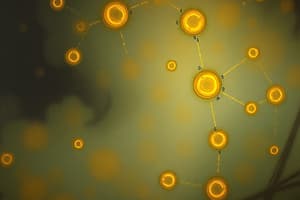Podcast
Questions and Answers
What does the atomic number (Z) represent?
What does the atomic number (Z) represent?
- Number of electrons in the nucleus
- Total number of particles in the nucleus
- Number of neutrons in the nucleus
- Number of protons in the nucleus (correct)
Which statement best describes the mass number (A)?
Which statement best describes the mass number (A)?
- Number of electrons in the nucleus
- Number of neutrons in the nucleus
- Number of protons + number of neutrons (correct)
- Number of protons in the nucleus
What are isotopes?
What are isotopes?
- Atoms of the same element with different numbers of neutrons (correct)
- Atoms of different elements with the same number of neutrons
- Atoms of the same element with different numbers of protons
- Atoms of different elements with the same mass number
What is the complete chemical symbol notation for the isotope of hydrogen with one proton and two neutrons?
What is the complete chemical symbol notation for the isotope of hydrogen with one proton and two neutrons?
What is the melting point of potassium?
What is the melting point of potassium?
Which of the following is a physical property of potassium?
Which of the following is a physical property of potassium?
Based on the text, which substance reacts with potassium?
Based on the text, which substance reacts with potassium?
What does the text define as 'Element'?
What does the text define as 'Element'?
In writing chemical formulas for ionic compounds, which of the following is always written first?
In writing chemical formulas for ionic compounds, which of the following is always written first?
What is the role of subscripts in the formula of an ionic compound?
What is the role of subscripts in the formula of an ionic compound?
Which type of compound is composed of a metal as the positive ion and a nonmetal as the negative ion?
Which type of compound is composed of a metal as the positive ion and a nonmetal as the negative ion?
If more than one compound can be formed from the same elements, what should be used to indicate the number of each kind of atom?
If more than one compound can be formed from the same elements, what should be used to indicate the number of each kind of atom?
What is the maximum volume of water, in liters, that the fish tank can hold?
What is the maximum volume of water, in liters, that the fish tank can hold?
What is the density of silver in g/cm3?
What is the density of silver in g/cm3?
What is the volume of blood in m3?
What is the volume of blood in m3?
What is the speed of the jogger in km/hr?
What is the speed of the jogger in km/hr?
Flashcards are hidden until you start studying
Study Notes
Atomic Structure
- Atomic number (Z) indicates the number of protons in an atom's nucleus and defines the element.
- Mass number (A) is the total number of protons and neutrons in an atom's nucleus.
Isotopes and Chemical Symbols
- Isotopes are variants of an element that have the same number of protons but different numbers of neutrons.
- The complete chemical symbol for the hydrogen isotope with one proton and two neutrons is ^3H or tritium.
Physical Properties and Reactivity
- Potassium has a melting point of approximately 63.5 °C.
- A physical property of potassium includes its accessibility and characteristic softness.
- Water is a substance that reacts vigorously with potassium, producing hydrogen gas and potassium hydroxide.
Chemical Notation and Ionic Compounds
- An 'Element' is defined as a pure substance that cannot be broken down into simpler substances by chemical means.
- In chemical formulas for ionic compounds, the positive ion (cation) is always written first.
- Subscripts in ionic compound formulas indicate the number of each type of atom present in the compound.
Compound Types and Quantities
- Ionic compounds consist of a metal cation paired with a nonmetal anion.
- When multiple compounds can form from the same elements, prefixes or subscripts are used to specify the number of each atom.
Measurements and Densities
- The maximum volume of a standard fish tank can hold varies greatly, but an example is often around 200 liters.
- The density of silver is approximately 10.49 g/cm³.
- The average volume of blood in an adult human is about 5 liters or 0.005 m³.
- A jogging speed averages around 8 km/hr, but varies based on individual stamina and pace.
Studying That Suits You
Use AI to generate personalized quizzes and flashcards to suit your learning preferences.




